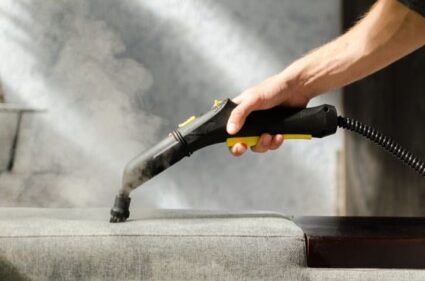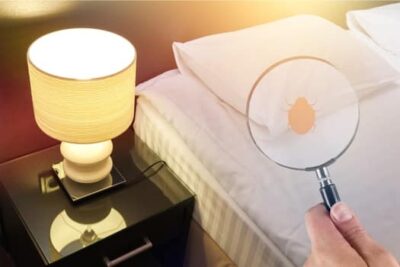Bed bugs are a growing problem in the United States. They can infest even the cleanest of homes, and can live in any piece of furniture in the home. You don’t even need to visit a disreputable motel to catch them as they might just be hiding in that dresser you just picked up from a garage sale.
Fully disassemble the furniture to inspect every surface. Check cracks and crevices for small, reddish-brown bugs and their shed exoskeletons. Pay attention to any small black spots/fecal stains. You can also use a magnifying glass to search for tiny white eggs.
This article will explore the kinds of furniture bed bugs can live in, and how to spot the signs of a bed bug infestation in a used item. We’ll also advise you on how to remove bed bugs from furniture, and offer some tips on how to shop for used furniture that is bed bug-free.
Which Kinds of Furniture Might Have Bed Bugs?
We already know that beds are a bed bug’s favorite hangout – the clue is in the name. They love to make their homes in mattresses, sheets, box springs, and bed frames.
But what many people don’t realize is that bed bugs can infest all sorts of furniture – and not just bedroom furniture. They can live in practically any room in the house, and make their homes anywhere that is close to humans. That includes the interior and upholstery of used cars.
To start with, let’s have a look at which types of furniture bed bugs might live in.
Can Bed Bugs Live in Wood Furniture?
Bed bugs don’t eat or burrow into wood, like termites or carpenter ants. However, they can make use of the already existing cracks and crevices. Wooden furniture contains many joins, gaps, and hinges – tiny spots which are perfect for bed bugs to hide out in, away from prying eyes.
You may find bed bugs in any wood furniture, but furniture that is usually kept in the bedroom can be particularly susceptible. This may include:
- Nightstands
- Chests of drawers
- Dressers and vanities
- Wardrobes
- Bookcases and shelving units
- Desks
Furniture which has lots of engraved designs, cracks or other small crevices has a better chance of housing bed bugs. Smooth furniture naturally has fewer places for the bugs to hide in.
Can Bed Bugs Live in Leather Furniture?
Have you found bed bugs in couch but nowhere else? Bed bugs aren’t limited to beds and dressers. They can make their home in almost any piece of furniture, no matter the material. And in fact, furniture upholstered with leather or other soft fabric provides many potential hiding spots.
Bed bugs can easily sneak in between the couch cushions, and down the back of the couch. If the cushions have removable covers, the bugs can even get inside them.
People don’t often suspect it, but a couch can be just as viable as a bed for a bed bug hiding place. As long as the bugs have access to their food source (human blood), it doesn’t matter where they live. They don’t always wait until you’re asleep to feed.
Can Bed Bugs Live in Appliances?
Finally, you may be wondering whether bed bugs can live in other kinds of fixtures and fittings, such as appliances. Sadly, not even electronics are safe from an infestation.
You probably won’t find bed bugs in ovens or freezers, or anywhere that the temperature is too extreme. They also wouldn’t be a fan of the dishwasher or washing machine. However, bed bugs can certainly live in lamps, computer keyboards, televisions, speakers and even inside power strips. As long as there is a gap as thin as a credit card, that’s big enough for a bed bug to crawl inside.
Signs of Bed Bugs in Wood Furniture
The signs of a bed bug infestation are the same no matter where the bed bugs are hiding: in a mattress or box spring, in a carpet or even in a piece of wooden furniture.
However, because a piece of furniture may have many small places for bed bugs to hide, the signs may not be obvious at first glance.
To check a piece of furniture for bed bugs, the first step is to disassemble the furniture as thoroughly as you can. Remove and take apart any drawers, doors, and shelves. Then, carefully examine each piece for the following signs. Pay particular attention to small, dark spaces, such as joints and hinges.
- Small black spots that look like ink. These are fecal spots – the remnants of bed bug poop. The spots may be flat or slightly raised if the wood is varnished.
- Bed bug casings, made of shed exoskeletons. These are small, oval, pale brown and slightly transparent.
- Tiny eggs and eggshells. These are white and slightly clear, and only around 1mm long.
- Live bugs. Bed bugs are oval shaped and reddish brown, with six legs and short antennae. Unfed bugs are very flat.
You may even notice a strong, musty smell coming from an infested piece of furniture. It is not always present, and some people appear to be able to smell it better than others. Many people describe the scent as “sickly sweet,” reminiscent of rotting berries.

How To Remove Bed Bugs From Wood Furniture
If you have found evidence of bed bugs inside your furniture, you’ll have to make a decision. Can the furniture be saved, or would any efforts amount to “too little too late”?
One thing is for sure – you can’t just ignore the problem. According to the scientific journal Insects, a bed bug population doubles in size every 13 days.
So, what options do you have?
Insecticides
The first treatment you might consider is the use of insecticides. These are chemicals that kill insects, such as bed bugs, upon contact. There are three main types of insecticides.
- Chemical-based insecticides, such as pyrethroids. These are extremely lethal to bed bugs and work instantly, killing them on contact. Most commercially available “bed bug killer” products are pyrethroid-based. They usually come in the form of a liquid, sometimes in a spray bottle. Unfortunately, according to the American Chemical Society, many bed bug populations are becoming genetically resistant to pyrethroids due to their overuse.
- Desiccants, such as diatomaceous earth. These work by drying the bed bugs out, so that they eventually die from dehydration. Bed bugs can’t become resistant to desiccants like they can with other insecticides, but they’re harder to apply as they usually come in a powder form.
- “Natural” insecticides, such as essential oil-based products. These tend to be safer to use around pets and children, so are often favored by families. However, their efficacy is debatable.
While insecticides are a great way of killing bed bugs on contact, they can be hard to use on furniture. Bed bugs are adept at fitting into small gaps where pesticides might not reach.
Unless you saturate the furniture with the product, you might end up missing some. A female bed bug can lay up to 6 eggs per day, so if you miss even one bug, your infestation may return.
Steam Treatment
The next step up from insecticides is steam treatment. Bed bugs and their eggs die when exposed to high temperatures, and using a steam cleaner is a great way to introduce these temperatures to your furniture. These machines allow you to deliver scalding steam directly into every inch of the furniture, so that every possible crevice is dealt with.
You’ll need to use a commercial steamer which is capable of reaching temperatures over 160 degrees Fahrenheit to kill all of the bugs. Hand-held clothes steamers and carpet cleaners may not produce hot enough steam to be effective.
Though steam cleaners are expensive, steaming is the most reliable way of ridding a piece of furniture of bed bugs. However, with wooden furniture, be careful: excessive heat and moisture can cause wooden surfaces to bend and warp.
Cutting Your Losses
Sometimes, it’s better to throw out the offending item rather than trying to remove bed bugs from it. This is especially the case with very large items with lots of cracks and crevices, or upholstered furniture, like couches and padded chairs.
Bed bugs can sneak deep into the foam and wedge themselves between the padding and the base. If the item has lots of hinges, screw holes or other tiny areas, there are plenty of places to hide. Even a steam cleaner may not be able to penetrate deeply enough.
The safest way to deal with an infested item is to throw it away. It’s often not worth the risk of attempting to treat the furniture. In the process, the bed bugs may escape and infest the rest of your home.
How to Find Bed Bug-Free Used Furniture
Now that you know how to recognize and remove bed bugs from furniture, let’s go through some tips for shopping for used furniture safely.
Remember, prevention is much better than cure. It’s far better to stay away from potentially infested furniture in the first place than attempt to eradicate bed bugs from your home.
Don’t Scavenge Furniture
There may come a day when you discover a nice-looking couch or wardrobe just sitting at the end of someone’s driveway, waiting to be thrown out.
It might be tempting, in such a situation, to “rescue” the used furniture and give it a second life in your own abode.
However, don’t fall into the trap of rehoming furniture that someone else is throwing out. If it looks too good to be true, it probably is. There’s always going to be a reason that they’re dumping it instead of selling it. Bed bugs may be the answer.
In an ideal world, everyone leaving infested furniture outside for collection would also leave note warning passers-by about the bed bugs. However, very few people do. Be on the safe side and leave it where it is.
Don’t Buy Used Furniture Online
It’s unfortunate, but it’s true – there are sellers out there on sites such as eBay who sell bed bug-ridden furniture to the unsuspecting public. And of course, they won’t mention it in the listing, especially if they’re trying to make decent money.
It isn’t always intentional, either – sometimes, the seller may not even realize that the item is playing host to bed bugs.
If you get an item delivered to your home, you may be opening the door to unwanted guests. By the time you’ve realized that the furniture is infested, it could be too late. The bed bugs could have already escaped, and penetrated the farthest corners of your home.
Inspect Furniture Thoroughly Before Leaving
If you’re buying used furniture from someone else’s home, or a thrift store, examine the item thoroughly before going through with the sale. As we’ve mentioned, bed bugs are tiny, and can hide in the smallest gaps.
No type of furniture is safe – bring a flashlight and a magnifying glass to help you check. If the seller doesn’t react well to this, or doesn’t want you to examine it closely, cut and run.
Make sure to carry out your inspections before putting the furniture in your vehicle to take it home. Bed bugs can and do infest cars, and can easily be brought into the home from your car.
Bear in mind that upholstered furniture can easily hide bed bugs, even with a thorough inspection. If in any doubt at all, stay away. It’s worth shelling out a little more for the peace of mind that comes with brand new furniture.


can bedbugs be in a baby crib that has been stored in a room for 15 years? (without the mattress; the mattress was vinyl)